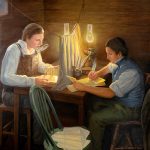Life Sketch from Foxes Book of Martyrs
Taken from the book Foxes Book of Martyrs.
Marcus Aurelius, followed about the year of our Lord 161, a man of nature more stern and severe; and, although in study of philosophy and in civil government no less commendable, yet, toward the Christians sharp and fierce; by whom was moved the fourth persecution.
The cruelties used in this persecution were such that many of the spectators shuddered with horror at the sight, and were astonished at the intrepidity of the sufferers. Some of the martyrs were obliged to pass, with their already wounded feet, over thorns, nails, sharp shells, etc. upon their points, others were scourged until their sinews and veins lay bare, and after suffering the most excruciating tortures that could be devised, they were destroyed by the most terrible deaths.
Martyrs
Germanicus
Germanicus, a young man, but a true Christian, being delivered to the wild beasts on account of his faith, behaved with such astonishing courage that several pagans became converts to a faith which inspired such fortitude.
Polycarp
Polycarp, the venerable bishop of Smyrna, hearing that persons were seeking for him, escaped, but was discovered by a child. After feasting the guards who apprehended him, he desired an hour in prayer, which being allowed, he prayed with such fervency, that his guards repented that they had been instrumental in taking him. He was, however, carried before the proconsul, condemned, and burnt in the market place.
The proconsul then urged him, saying, “Swear, and I will release thee;–reproach Christ.”
Polycarp answered, “Eighty and six years have I served him, and he never once wronged me; how then shall I blaspheme my King, Who hath saved me?” At the stake to which he was only tied, but not nailed as usual, as he assured them he should stand immovable, the flames, on their kindling the fagots, encircled his body, like an arch, without touching him; and the executioner, on seeing this, was ordered to pierce him with a sword, when so great a quantity of blood flowed out as extinguished the fire. But his body, at the instigation of the enemies of the Gospel, especially Jews, was ordered to be consumed in the pile, and the request of his friends, who wished to give it Christian burial, rejected. They nevertheless collected his bones and as much of his remains as possible, and caused them to be decently interred.
Felicitatis and her Sons
Felicitatis, an illustrious Roman lady, of a considerable family, and the most shining virtues, was a devout Christian. She had seven sons, whom she had educated with the most exemplary piety.
Januarius, the eldest, was scourged, and pressed to death with weights; Felix and Philip, the two next had their brains dashed out with clubs; Silvanus, the fourth, was murdered by being thrown from a precipice; and the three younger sons, Alexander, Vitalis, and Martial, were beheaded. The mother was beheaded with the same sword as the three latter.
Justin
Justin, the celebrated philosopher, fell a martyr in this persecution. He was a native of Neapolis, in Samaria, and was born A.D. 103. Justin was a great lover of truth, and a universal scholar; he investigated the Stoic and Peripatetic philosophy, and attempted the Pythagorean; but the behavior of our of its professors disgusting him, he applied himself to the Platonic, in which he took great delight. About the year 133, when he was thirty years of age, he became a convert to Christianity, and then, for the first time, perceived the real nature of truth.
He wrote an elegant epistle to the Gentiles, and employed his talents in convincing the Jews of the truth of the Christian rites; spending a great deal of time in travelling, until he took up his abode in Rome, and fixed his habitation upon the Viminal mount.
He kept a public school, taught many who afterward became great men, and wrote a treatise to confuse heresies of all kinds. As the pagans began to treat the Christians with great severity, Justin wrote his first apology in their favor. This piece displays great learning and genius, and occasioned the emperor to publish an edict in favor of the Christians.
Soon after, he entered into frequent contests with Crescens, a person of a vicious life and conversation, but a celebrated cynic philosopher; and his arguments appeared so powerful, yet disgusting to the cynic, that he resolved on, and in the sequel accomplished, his destruction.
The second apology of Justin, upon certain severities, gave Crescens the cynic an opportunity of prejudicing the emperor against the writer of it; upon which Justin, and six of his companions, were apprehended. Being commanded to sacrifice to the pagan idols, they refused, and were condemned to be scourged, and then beheaded; which sentence was executed with all imaginable severity.
Several were beheaded for refusing to sacrifice to the image of Jupiter; in particular Concordus, a deacon of the city of Spolito.
Miraculous Deliverance
Some of the restless northern nations having risen in arms against Rome, the emperor marched to encounter them. He was, however, drawn into an ambuscade, and dreaded the loss of his whole army. Enveloped with mountains, surrounded by enemies, and perishing with thirst, the pagan deities were invoked in vain; when the men belonging to the militine, or thundering legion, who were all Christians, were commanded to call upon their God for succor. A miraculous deliverance immediately ensued; a prodigious quantity of rain fell, which, being caught by the men, and filling their dykes, afforded a sudden and astonishing relief. It appears that the storm which miraculously flashed in the face of the enemy so intimidated them, that part deserted to the Roman army; the rest were defeated, and the revolted provinces entirely recovered.
This affair occasioned the persecution to subside for some time, at least in those parts immediately under the inspection of the emperor; but we find that it soon after raged in France, particularly at Lyons, where the tortures to which many of the Christians were put, almost exceed the powers of description.
Persecution in France
The principal of these martyrs were Vetius Agathus, a young man; Blandina, a Christian lady, of a weak constitution; Sanctus, a deacon of Vienna; red hot plates of brass were placed upon the tenderest parts of his body; Biblias, a weak woman, once an apostate. Attalus, of Pergamus; and Pothinus, the venerable bishop of Lyons, who was ninety years of age. Blandina, on the day when she and the three other champions were first brought into the amphitheater, she was suspended on a piece of wood fixed in the ground, and exposed as food for the wild beasts; at which time, by her earnest prayers, she encouraged others. But none of the wild beasts would touch her, so that she was remanded to prison. When she was again produced for the third and last time, she was accompanied by Ponticus, a youth of fifteen, and the constancy of their faith so enraged the multitude that neither the sex of the one nor the youth of the other were respected, being exposed to all manner of punishments and tortures. Being strengthened by Blandina, he persevered unto death; and she, after enduring all the torments heretofore mentioned, was at length slain with the sword.
When the Christians, upon these occasions, received martyrdom, they were ornamented, and crowned with garlands of flowers; for which they, in heaven, received eternal crowns of glory.
The Catacombs
It has been said that the lives of the early Christians consisted of “persecution above ground and prayer below ground.” Their lives are expressed by the Coliseum and the catacombs. Beneath Rome are the excavations which we call the catacombs, whivch were at once temples and tombs. The early Church of Rome might well be called the Church of the Catacombs. There are some sixty catacombs near Rome, in which some six hundred miles of galleries have been traced, and these are not all. These galleries are about eight feet high and from three to five feet wide, containing on either side several rows of long, low, horizontal recesses, one above another like berths in a ship. In these the dead bodies were placed and the front closed, either by a single marble slab or several great tiles laid in mortar. On these slabs or tiles, epitaphs or symbols are graved or painted. Both pagans and Christians buried their dead in these catacombs. When the Christian graves have been opened the skeletons tell their own terrible tale. Heads are found severed from the body, ribs and shoulder blades are broken, bones are often calcined from fire. But despite the awful story of persecution that we may read here, the inscriptions breathe forth peace and joy and triumph. Here are a few:
-
-
- “Here lies Marcia, put to rest in a dream of peace.”
-
-
-
- “Lawrence to his sweetest son, borne away of angels.”
-
-
-
- “Victorious in peace and in Christ.”
-
-
-
- “Being called away, he went in peace.”
-
-
-
- Remember when reading these inscriptions the story the skeletons tell of persecution, of torture, and of fire.
-
-
-
- But the full force of these epitaphs is seen when we contrast them with the pagan epitaphs, such as:
-
-
-
- “Live for the present hour, since we are sure of nothing else.”
-
-
-
- “I lift my hands against the gods who took me away at the age of twenty though I had done no harm.”
-
-
-
- “Once I was not. Now I am not. I know nothing about it, and it is no concern of mine.”
-
-
-
- “Traveler, curse me not as you pass, for I am in darkness and cannot answer.”
-
The most frequent Christian symbols on the walls of the catacombs, are, the good shepherd with the lamb on his shoulder, a ship under full sail, harps, anchors, crowns, vines, and above all the fish.







